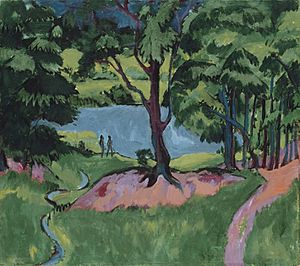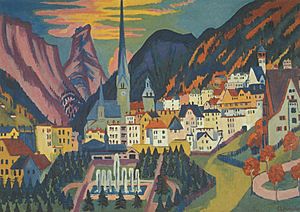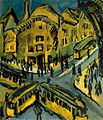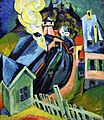Ernst Ludwig Kirchner facts for kids
Quick facts for kids
Ernst Ludwig Kirchner
|
|
|---|---|
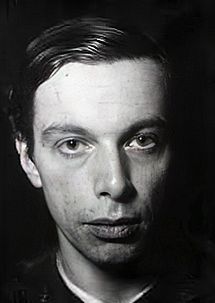
Photographic self-portrait 1919
|
|
| Born |
Ernst Ludwig Kirchner
6 May 1880 Aschaffenburg, Kingdom of Bavaria, German Empire
|
| Died | 15 June 1938 (aged 58) Frauenkirch-Wildboden, Davos, Switzerland
|
| Education | Königliche Technische Hochschule |
| Known for | Painting and printmaking |
| Movement | Expressionism |
| Burial place | Waldfriedhof Cemetery, Davos |
| Signature | |
Ernst Ludwig Kirchner (May 6, 1880 – June 15, 1938) was a famous German painter and printmaker. He was a key figure in a style of art called Expressionism. Kirchner helped start an important artists' group called Die Brücke, which means "The Bridge." This group was very important in creating Expressionism in the 20th century.
During the First World War, Kirchner joined the army. However, he soon faced health challenges and was discharged. In 1933, the Nazis labeled his art as "degenerate" (meaning "unwanted" or "bad"). By 1937, over 600 of his artworks were either sold or destroyed.
Contents
Kirchner's Early Life and Art Journey
Ernst Ludwig Kirchner was born in Aschaffenburg, Bavaria, Germany. His family moved often because his father was looking for work. Eventually, his father became a professor in Chemnitz.
Becoming an Artist: Studying and Creating
In 1901, Kirchner began studying architecture in Dresden. This school also taught drawing and art history. There, he met Fritz Bleyl, and they became good friends. They shared a strong interest in art and nature. Kirchner continued his studies in Munich before returning to Dresden in 1905.
Founding "The Bridge" Art Group
In 1905, Kirchner, Bleyl, and two other architecture students, Karl Schmidt-Rottluff and Erich Heckel, started an art group. They called it Die Brücke ("The Bridge"). From this point, Kirchner decided to focus entirely on art.
The group wanted to move away from old, traditional art styles. They aimed to find a new way to express themselves through art. Their goal was to build a "bridge" between past art and new, modern art. They looked at older artists like Albrecht Dürer and also at new art movements. They also brought back older art methods, especially woodcut prints.
The Birth of Expressionism
"The Bridge" group was very important for modern art in the 20th century. They helped create the art style known as Expressionism. The group first met in Kirchner's studio, which used to be a butcher's shop. It was a very artistic and creative space.
Kirchner's studio became a place where artists could break old social rules. They held drawing sessions with models who were friends, not professional models. They used quick poses to encourage spontaneous art.
In 1906, Kirchner wrote a statement for the group. It said that anyone who creates art directly from their feelings "belongs to us." The group held their first art show in Dresden in late 1906.
Life and Art in Berlin
In 1906, Kirchner met Doris Große, who became his favorite model for several years. He spent summers by lakes and on an island called Fehmarn with other "Bridge" members. In 1911, he moved to Berlin.
In Berlin, he tried to start a private art school with Max Pechstein. It was called MIUM-Institut, meaning "modern teaching of painting." However, it didn't succeed and closed the next year. Around this time, he started a relationship with Erna Schilling that lasted his whole life.
In 1913, Kirchner wrote a history of "The Bridge" group. This writing led to the group breaking up. He then had his first solo art show in Essen. For the next two years, he painted a series of "Straßenszenen" (street scenes) showing the busy streets of Berlin.
Challenges During World War I
When World War I began in 1914, Kirchner volunteered for the army. However, he soon became unwell and was discharged in 1915. He returned to Berlin and continued to paint, creating works like Self-Portrait as a Soldier (1915). He needed medical care and spent time in sanatoriums (special hospitals).
Even while unwell, Kirchner kept working. He produced many oil paintings and drawings. His art shows began to do well, and he started earning more money.
Life and Art in Davos
In 1917, Kirchner moved to Davos, Switzerland, for his health. He found the high mountains helpful for his recovery. He wrote that he wanted to "remain in the world and for the world."
Finding Peace and Inspiration in the Mountains
Kirchner moved into a house in Frauenkirch, near Davos. He decorated it with furniture he carved himself. He wrote that his kitchen looked like a famous painter's studio. Kirchner slowly recovered his health. His partner, Erna Schilling, visited him often while also managing his art business in Berlin.
His health improved quickly in 1919 and 1920, and he continued to create art. His fame grew with several exhibitions in Germany and Switzerland. He found many new subjects to paint by getting to know the local farmers. He was amazed by the people of Davos, describing them as proud and hardworking. He felt happy and grateful to be there.
Kirchner even started writing about his own art using a fake name, Louis de Marsalle. He did this to guide public opinion and not rely on art critics.
New Models and New Homes
In 1921, a big show of Kirchner's art was held in Berlin, and it received good reviews. He met a dancer named Nina Hard and invited her to Frauenkirch. She became an important model for many of his artworks. Kirchner also started designing carpets, which were woven by Lise Gujer.
In 1923, Kirchner moved to a new house called Wildboden. He wrote that it would be a "turning point" in his life. The house had views of Frauenkirch and Davos, and these landscapes became subjects for many of his paintings.
Later Years and Growing Challenges
In 1925, Kirchner became friends with artist Albert Müller and his family. A new art group called Rot-Blau formed in Basel, and its members visited Kirchner for guidance. Kirchner traveled back to Germany briefly but preferred to work undisturbed in Frauenkirch.
Sadly, Albert Müller died in 1926. Kirchner organized a memorial exhibition for him. Kirchner's own art style became more abstract over time.
In 1931, he became a member of the Prussian Academy of Arts in Berlin. However, when the Nazi party came to power in Germany, it became very difficult for Kirchner to sell his art. In 1937, he was forced to leave the Prussian Academy of Arts.
Kirchner was deeply worried by the situation in Germany. He wrote about the destruction of art in museums, which upset him greatly. He had founded "The Bridge" to promote German art, and now his art was called "un-German."
In 1935, Kirchner offered to paint a mural for a new school in Frauenkirch, but the project changed. Instead, he created a sculpture for the schoolhouse door. He was happy to be included in the school's opening celebration.
Throughout 1936 and 1937, Kirchner faced more health issues. In 1937, the "Degenerate Art Exhibition" took place in Germany. A total of 639 of Kirchner's artworks were removed from museums, and 25 were shown in this exhibition to be mocked.
Kirchner continued to work, but he became increasingly distressed by the political situation. After Austria was taken over by Germany, Kirchner worried that Germany might invade Switzerland. On June 15, 1938, Kirchner's life ended tragically in front of his home in Frauenkirch. He was buried three days later in the Waldfriedhof cemetery. Erna Schilling continued to live in their home until her death in 1945.
Kirchner's Lasting Impact
Kirchner's art was first shown publicly in the United States in 1913 at the Armory Show. This was a major event for modern art in America. By 1921, U.S. museums began buying his work. His first solo museum show in the U.S. was in Detroit in 1937.
Many of Kirchner's art collectors were Jewish and were persecuted by the Nazis. They had to sell their collections to escape or had their art seized. For example, Kirchner's painting Berlin Street Scene was owned by Alfred Hess, whose widow was forced to give it up. Another painting, Artillerymen, was owned by Alfred Flechtheim, whose gallery was taken by the Nazis.
Kirchner's painting Sand Hills in Engadine was seized by the Nazis in 1935. It later ended up in the Museum of Modern Art (MoMA) but was returned to the owner's family in 2015.
A large painting called Bathers (1916), which the Nazis destroyed, has been recreated at the Kirchner Museum in Davos. In 2006, one of Kirchner's paintings, Street Scene, Berlin (1913), sold for $38 million, setting a record for his art.
Images for kids
-
Moonrise, Soldier and Maiden, 1905, Museum of Fine Arts, Houston
-
Sitting Woman (Dodo), 1907, Pinakothek der Moderne, Munich
-
Woman with Black Hat, 1908, Solomon R. Guggenheim Museum
-
Head of a Woman, ca. 1909, Solomon R. Guggenheim Museum
-
Tavern, 1909, Saint Louis Art Museum, Saint Louis
-
Fränzi in front of Carved Chair, 1910, Museo Thyssen-Bornemisza, Madrid
-
Portrait of a Woman, 1911, Saint Louis Art Museum
-
At the Table, 1916, Solomon R. Guggenheim Museum
-
Two Brothers, 1921, Pinakothek der Moderne, Munich
-
Old Woman and Young Woman, 1921, Solomon R. Guggenheim Museum
Books About Kirchner
- Krämer, Felix. Kirchner, Hatje Cantz, 2010. ISBN: 978-3-7757-2553-8
- Wye, Deborah. Kirchner and the Berlin Street, The Museum of Modern Art, New York, 2008. ISBN: 978-0-87070-741-4
- Kort, Pamela. Ernst Ludwig Kirchner: Berlin Street Scene, Neue Galerie New York, 2008. ISBN: 978-1-931794-15-2
- Ernst Ludwig Kirchner: Imaginary Travels Prestel, 2018
See also
 In Spanish: Ernst Ludwig Kirchner para niños
In Spanish: Ernst Ludwig Kirchner para niños


